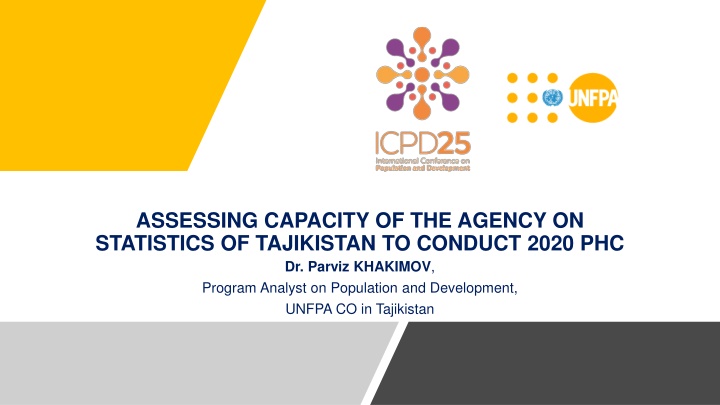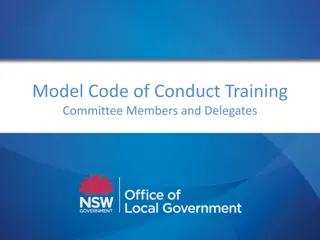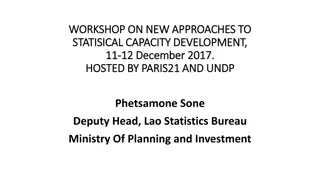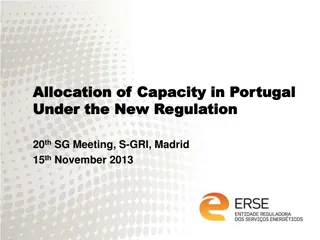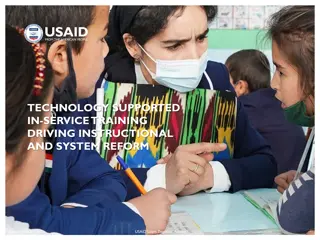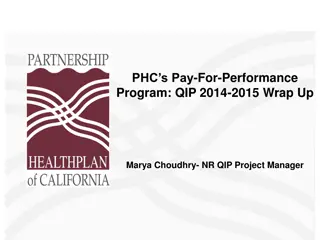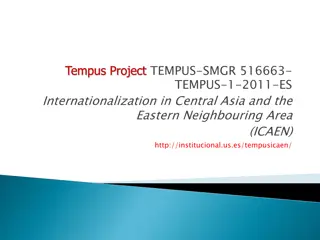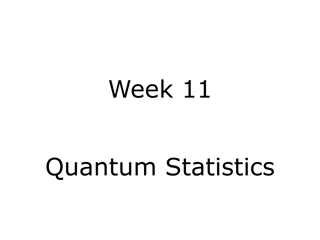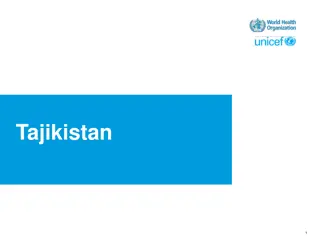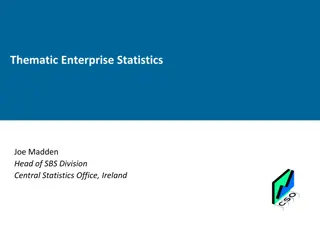ASSESSING CAPACITY OF THE AGENCY ON STATISTICS OF TAJIKISTAN TO CONDUCT 2020 PHC
Assessing the capacity of Tajikistan's Agency on Statistics to conduct the 2020 Population and Housing Census, focusing on internal capacities, areas for support, and action plan development using the U.S. Census Bureau's TASC tool.
Download Presentation

Please find below an Image/Link to download the presentation.
The content on the website is provided AS IS for your information and personal use only. It may not be sold, licensed, or shared on other websites without obtaining consent from the author.If you encounter any issues during the download, it is possible that the publisher has removed the file from their server.
You are allowed to download the files provided on this website for personal or commercial use, subject to the condition that they are used lawfully. All files are the property of their respective owners.
The content on the website is provided AS IS for your information and personal use only. It may not be sold, licensed, or shared on other websites without obtaining consent from the author.
E N D
Presentation Transcript
ASSESSING CAPACITY OF THE AGENCY ON STATISTICS OF TAJIKISTAN TO CONDUCT 2020 PHC Dr. Parviz KHAKIMOV, Program Analyst on Population and Development, UNFPA CO in Tajikistan
OBJECTIVE OF THE ASSESSMENT The objective of the assessment are three folds: to define internal/existed capacities that can be replicate for PHC; to define the areas of further support/assistance; to develop an action plan in this stage.
AN APPROACH The U.S. Census Bureau s Tool for Assessing Statistical Capacity (TASC) are employed with the aim to provide a quantitative measure of the capacity of Agency on Statistics under the President Tajikistan to conduct 2020 PHC. (AS) of the Republic of Each of the operational modules is divided into four subsections, except Institutional Capacity and Administrative Records modules: Human and physical capital; Methodological soundness and international standards; Quality assurance; Written procedures and documentation.
AN APPROACH The Institutional Capacity module asks questions concerning: Legal Environment; Data confidentiality & Protection; Organizational Structure; Human and Physical Capital; Stakeholders Coordination.
AN APPROACH The Administrative Records module asks questions concerning: The legal basis for the use of administrative records; The skills of staff to link records; The harmonization of concepts and definitions between the various registers; Availability and use of metadata in linkages.
OUTLINE OUTLINE 1. Overall Capacity 2. Institutional Capacity 3. Planning and Managing 4. Mapping 5. Sampling 6. Questionnaire Content and Testing 7. Field Operations 8. Data Processing 9. Data Analysis and Evaluation 10. Data Dissemination 11. Publicity 12. Mobile Data Capture 13. Administrative Records
1. Overall Capacity of the AS on 2020 PHC 1. Overall Capacity of the AS on 2020 PHC Assessing Overall Capacity 100% 96% 81% 67% 50% 54% 51% 50% 44% 41% 39% 23% 5% 0%
2. Institutional Capacity 2. Institutional Capacity 100% Institutional Capacity 100% 80% 67% 50% 47% 42% 0% Legal Environment Data Confidentiality and Protection Organizational Structure Human and Physical Capital Stakeholder Coordination
3. Planning and Managing Planning and Management 100% 50% 33% 33% 33% 17% 0% Human and Physical Capital Methodological Soundness and International Standards Quality Assurance Written Procedures and Documentation
4. Mapping Mapping 100% 50% 13% 0% 0% 7% 0% Human and Physical Capital Methodological Soundness and International Standards Quality Assurance Written Procedures and Documentation
Mapping To strengthen the capacity on using map for PHC the following steps need to be taken: The AS should works with Land Committee, Geodesy and Cadastre and any other national mapping agencies to obtain spatial data (such as topography, roads, legal boundaries) to avoid duplication of effort. AS should established mapping unit within Census Department and organized a training or hire the experienced staff in uses of Geographic Information Systems (GIS), including: collection, preparation, use, and publication of maps and management of geospatial data for census/survey purposes; creating thematic maps to highlight a specific topic; implementation and basic technology requirements; database development and management; freely data dissemination through AS website (e.g., shapefiles, geodatabases, KML) all geospatial datasets of administrative/statistical geography; produce maps using GIS software for enumeration;
Mapping thorough review of map dissemination products before they are publicly released (data accuracy, correct positioning, clarity of map elements, etc.); GPS-verified national datasets uses for census/survey operations (e.g., road network, housing location points, or landmarks); digitization and integration of digitized data from different sources; updates spatial data to reflect changes in administrative boundaries and re-delineate statistical areas; developing enumeration area maps to facilitate enumerator orientation meaning that they are legible, scaled appropriately, have clear and unambiguous boundaries, and are designed so that an enumerator can canvass the entire area in the time allotted; if available, use of satellite or aerial imagery to verify physical features (housing units, roads, rivers) and boundaries; verify pertinent spatial data (e.g., boundaries, housing units, structures) in the field prior to enumeration; (xiv) instruction of enumerators to note errors, inconsistencies, or updates in their EAs and the update the spatial database after verification; prepare formal training materials for field staff detailing how to read maps, how to use maps during enumeration, and how to correct map errors; produce or manage the delivery of reference and thematic maps via the AS website using multiple formats, including interactive web maps and static map products.
Mapping Mapping unit has a formal plan inventories should kept of geospatial products, including: GIS databases; Datasets; map products an covering the entire census/survey mapping process, including review of existing maps and data; interaction with other government mapping offices; digitizing; fieldwork; map correction and revision; map production. Mapping staff should have hardware (e.g., computers, plotters, or servers) and software that are up to date, sufficient to complete required tasks, and adequately supported by SCS IT staff; GIS data sets and databases should documented with standardized metadata that includes data sources, authors, production methods, and dates of production.
5. Sampling Sampling 100% 67% 50% 33% 0% 0% 0% Human and Physical Capital Methodological Soundness and International Standards Quality Assurance Written Procedures and Documentation
6. Questionnaire Content and Testing Questionnaire Content and Testing 100% 100% 83% 67% 58% 50% 0% Human and Physical Capital Methodological Soundness and International Standards Quality Assurance Written Procedures and Documentation
7. Field Operations Field Operations 100% 100% 100% 92% 92% 50% Human and Physical Capital Methodological Soundness Quality Assurance Written Procedures and Documentation and International Standards
8. Data Processing Data Processing 100% 77% 60% 50% 33% 20% 0% Human and Physical Capital Methodological Soundness and International Standards Quality Assurance Written Procedures and Documentation
9. Data Analysis & Evaluation Data Analysis and Evaluation 100% 50% 25% 25% 0% 7% 0% Human and Physical Capital Methodological Soundness and International Standards Quality Assurance Written Procedures and Documentation
10. Data Dissemination Data Dissemination 100% 50% 56% 50% 50% 13% 0% Human and Physical Capital Methodological Soundness and International Standards Quality Assurance Written Procedures and Documentation
11. Publicity Publicity 100% 67% 50% 33% 28% 17% 0% Human and Physical Capital Methodological Soundness Quality Assurance Written Procedures and Documentation and International Standards
12. Mobile Data Capture CAPI Summary 100% 50% 53% 44% 22% 12% 0% Human and Physical Capital Methodological Soundness and International Standards Quality Assurance Written Procedures and Documentation
Mobile Data Capture The capacity of the SCS to employ mobile data capture is weak For PHC should procedures in place for what to do, when questionnaires and/or mobile devices are lost or stolen. Backup questionnaires and/or mobile devices should available throughout the country to avoid delays; a multi-disciplinary working group should establish that includes experts in design, field operations, and programming and analysis that make joint decisions; a multi-disciplinary working group should evaluate the advantages and disadvantages of using mobile data capture; a multi-disciplinary working group should evaluate the infrastructure and resource requirements of such a system and the readiness of the SCS to deliver such a system given constraints (time, budget, scope); SCS can program devices with access to imagery and vector map data; edits can be made to census geography in the field and stored in the same format as the centralized data;
Mobile Data Capture the enumeration universe should be populate programmatically based on the centralized data captured during the housing unit listing operation and quality assurance is an integrated part of the listing software control system; the SCS should have the resources to design and deploy a digital data storage and transmission system that protects data security to best practice standards; SCS centrally stores and integrates the captured spatial data with subsequent census or survey operations for address/housing unit listing; a digital system should create by the SCS that links the enumerator to the device and to the enumeration area. The system allows for reassignment; testing should be done to simulate data transmission and load-testing (simulating the amount of data that could be downloaded to a server at one time). A system should be in place that monitors data capture rates, evaluating performance against benchmarks and directing corrective action if benchmarks are not met;
Mobile Data Capture A system for verifying data capture activity should be in place and the process should be responsive to feedback based on verification: KEYING: keying operator progress is monitored for accuracy; SCANNING: OMR and OCR accuracy are sampled, supplemental keying by operators verified for accuracy; MOBILE DATA CAPTURE: operational control system includes simultaneous data verification SCS permanent staff should has following expertise for all steps of the data capture system: KEYING: 1) create a data entry program, 2) program skip patterns and range and consistency checks; SCANNING: 1) design a form that meets the specifications of the scanning system; 2) set and monitor quality assurance standards for printing; 3) create a program that can capture the data from the form; MOBILE DATA CAPTURE: 1) create a program that enables field data capture 2) create a program that manages assignments and data transfer, 3) incorporate maps.
Mobile Data Capture Questionnaires should designed and tested in accordance with the data capture system chosen: KEYING: 1) designed for keyer speed and accuracy, 2) minimized page flipping; SCANNING: 1) tested for handwriting clarity and darkness, 2) accuracy is checked for character recognition, 3) formatted for accurate scanning; MOBILE DATA CAPTURE: 1) taken advantage of easier inclusion of skip patterns or filter questions, 2) conducted content usability testing, 3) conducted device usability testing Enumerator training should include aspects specific to the data processing system used: KEYING: 1) handwriting practice; SCANNING: 1) handwriting practice, 2) using appropriate writing instrument, 3) handling of questionnaires; MOBILE DATA CAPTURE: 1) how and how often to charge the device; 2) how to fill out the questionnaire and use the map; 3) how and how often to transmit data, and; 4) troubleshooting. Most advanced data archival and data processing software and hardware need to be used for PHC; Change control and version management procedures should be used when developing requirement and specifications for hardware and software and it should be systematic.
13. Administrative Records Administrative Records 100% 75% 50% 33% 0% 0% 0% Human and Physical Capital Methodological Soundness and International Standards Quality Assurance Written Procedures and Documentation
THANK YOU! THANK YOU!
